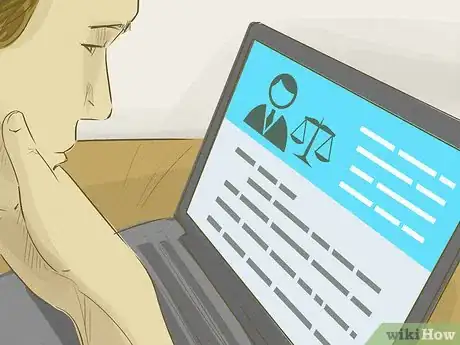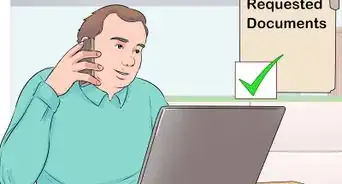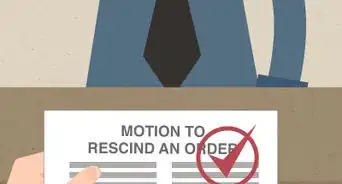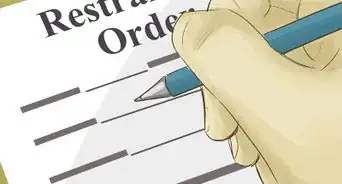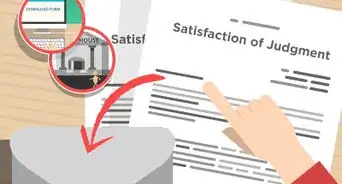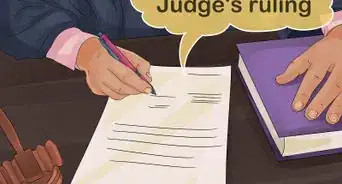This article was co-authored by Clinton M. Sandvick, JD, PhD. Clinton M. Sandvick worked as a civil litigator in California for over 7 years. He received his JD from the University of Wisconsin-Madison in 1998 and his PhD in American History from the University of Oregon in 2013.
This article has been viewed 29,975 times.
A protective order is also called a “restraining order.” When someone feels threatened by you, they can go to court and get a protective order. This person is called the Petitioner. The protective order prohibits you from a variety of actions, such as contacting the Petitioner or coming within a certain distance of him or her. In Indiana, protective orders are typically sought against an intimate partner. To fight the protective order, you need to hire an experienced attorney and prepare for a hearing.
Steps
Preparing to Fight the Order
-
1Read the order. The county sheriff will probably serve you with a copy of the protective order. Protective orders can be issued “ex parte,” which means that the judge issues it without hearing from you. The order should lay out what you are prohibited from doing: contacting the Petitioner, possessing a firearm, etc.
- You may also be served a summons or a Notice of Hearing along with the order. These documents will inform you whether or not a hearing has been scheduled. If one has, then you will need to prepare for it. If no hearing has been scheduled, then you will have to ask the court for a hearing by filing a “Verified Request for a Hearing.”
-
2Observe the conditions of the protective order. Until you get the protective order overturned, you need to follow the conditions set in it, no matter how unfair you think they are. If you violate your protective order, then you commit the crime of Invasion of Privacy, as well as possibly other crimes.[1]
- You may also be prosecuted for civil or criminal contempt. Both criminal and civil contempt could result in you being jailed.[2]
- You are also not allowed to contact the Petitioner even if he or she reaches out to you.[3] For this reason, you should not answer phone calls from the petitioner, respond to emails, or open the door if the Petitioner shows up on your doorstep. Instead, call the police.
Advertisement -
3Find an attorney. You increase your chances of having the protective order dissolved if you are represented by a competent attorney. Your attorney should have experience representing defendants of protective orders.
- For tips on how to find an effective attorney, see Find a Good Attorney.
-
4Request a copy of the applicant’s affidavit. As part of the application for a protective order, the applicant had to file an affidavit in which the Petitioner listed why they were afraid of you. You should try to get a copy of this affidavit and read it, looking for lies or omissions.
- Your lawyer will know how to request a copy of the affidavit. Your defense will depend in large part on refuting the charges made in it.
- For example, if the Petitioner complained that you threatened to kill her, you need evidence that you never made that threat.
-
5Gather evidence. Based on the allegations made in the affidavit, you need evidence that can cast doubt on those allegations. You also might want evidence that casts doubt on the Petitioner’s credibility as well.
- For example, if you have evidence that the Petitioner was drunk during any altercation, then you can cast doubt on his or her ability to remember or perceive what was happening. Look for receipts for purchases of alcohol, credit card statements that show a night out at the bar, or another witness that can testify that the Petitioner was drunk.
- Useful evidence will depend on the substance of the allegations. Your attorney should have ideas about how you can rebut the Petitioner’s allegations.
Appealing the Protective Order
-
1Get a Request for a Hearing form. You need to file a document called “Respondent’s Verified Request for a Hearing.” You can ask the court clerk for a form to fill out. Alternately, you can download the form at https://www.formalu.com/forms/44851/respondent-s-verified-request-for-a-hearing.
- Don’t wait. You must file within 30 days of receiving your copy of the protective order.[4] Accordingly, you should file the Request for Hearing as soon as possible.
-
2Fill out the form. Use either a typewriter or write legibly in blue or black ink. The form will request the following information:[5]
- the date the protective order was issued by the court
- the date that you received the copy of the order
- your daytime address and telephone number
-
3File. You should make two copies of the form: one for your records and the other for the Petitioner. You should take the original to the court clerk and ask to file.
- Be sure to ask the court clerk how you can serve notice on the Petitioner. This may differ depending on the court and whether the Petitioner wants to keep his or her whereabouts unknown. The court itself may notify the Petitioner.
Preparing for and Attending the Hearing
-
1Understand the purpose of the hearing. The only proper subject matter at the Protection Order hearing is domestic or family violence, stalking, and or sex offenses.[6] The hearing is not the time to discuss child support, alimony, or anything else. The court must decide the following:
- whether domestic or family violence, stalking, or a sex offense has occurred
- whether you (the Respondent) pose a credible threat to the safety of the Petitioner or the Petitioner’s household
- necessary relief to end the violence or threat of violence
-
2Study the state’s Protective Order statute. You should find and read Indiana’s law on protective orders. The law will outline who the Petitioner may get a protective order against and what conduct justifies the issuance of a protective order. Your defense will depend on arguing that the law does not apply to you.
- You can find the law on the Internet. Search “Indiana protective order statute.”
-
3Read Indiana’s rules of evidence. The state’s rules of evidence apply at the Protective Order hearing.[7] You can find Indiana’s rules of evidence at http://www.in.gov/judiciary/rules/evidence/. In particular, pay attention to the following:
- Hearsay. Hearsay is an out-of-court statement offered in court for the truth of the matter asserted in the statement. For example, if your ex-wife testifies that your child told her that you had abused him, then that statement cannot be offered as truth of the abuse. Hearsay statements are prohibited, and you should be prepared to challenge them at the hearing.[8]
-
4Present your defense at the hearing. You need to convince the judge that you should not be covered by the protective order. There are a couple ways you can do this:
- Challenge that the Petitioner qualifies for the protective order. According to Indiana law, a person can get a protective order against a person who commits domestic or family violence, stalking, or a sex offense. “Domestic violence” is further defined as threats or harm committed by a “family or household member.”[9]
- You could argue that, under this definition, you do not qualify as family or a household member because you were only a friend.
- Argue that you never threatened the Petitioner. The Petitioner cannot get a protective order unless they convince the judge that you have committed domestic or family violence, stalking, or a sex offense. You could argue that your conduct (such as shouting at someone) does not rise to the level of violence necessary to justify a protective order.
- Challenge that the Petitioner qualifies for the protective order. According to Indiana law, a person can get a protective order against a person who commits domestic or family violence, stalking, or a sex offense. “Domestic violence” is further defined as threats or harm committed by a “family or household member.”[9]
-
5Fill out an order. If you prevail and the judge dismisses the protective order, then you might be tasked with completing an order form. The court room should have blank forms that you can fill out. Alternately, the court clerk might fill out the form.
- Order forms are also available for download at the Indiana Judicial Center’s website.
References
- ↑ http://www.in.gov/judiciary/center/files/center-bb-po-deskbook.pdf
- ↑ http://www.in.gov/judiciary/center/files/center-bb-po-deskbook.pdf
- ↑ http://banksbrower.com/2015/08/08/indianapolis-criminal-defense-attorney-blog-a-look-at-protective-and-no-contact-orders-and-invasion-of-privacy/
- ↑ https://www.formalu.com/forms/44851/respondent-s-verified-request-for-a-hearing
- ↑ https://www.formalu.com/forms/44851/respondent-s-verified-request-for-a-hearing
- ↑ http://www.in.gov/judiciary/center/files/center-bb-po-deskbook.pdf
- ↑ http://www.in.gov/judiciary/center/files/center-bb-po-deskbook.pdf
- ↑ http://www.in.gov/judiciary/center/files/center-bb-po-deskbook.pdf
- ↑ http://www.in.gov/judiciary/admin/files/pubs-trial-court-protection-orders.pdf


